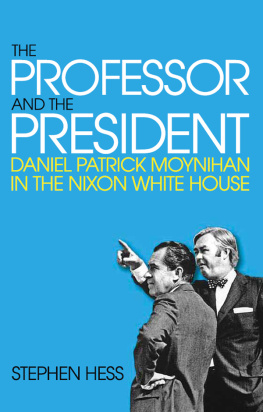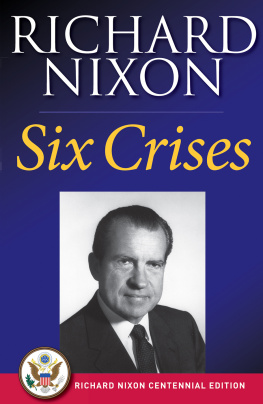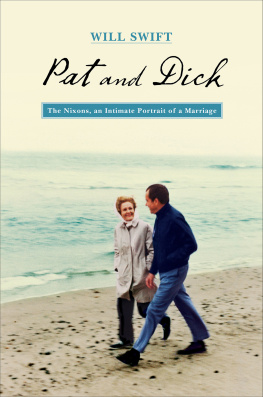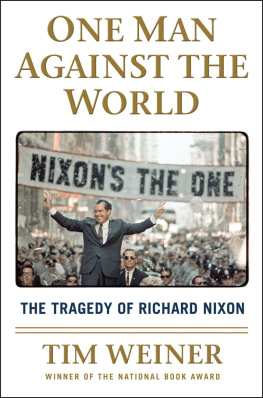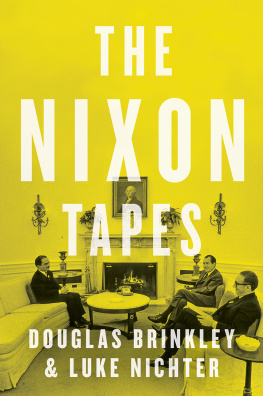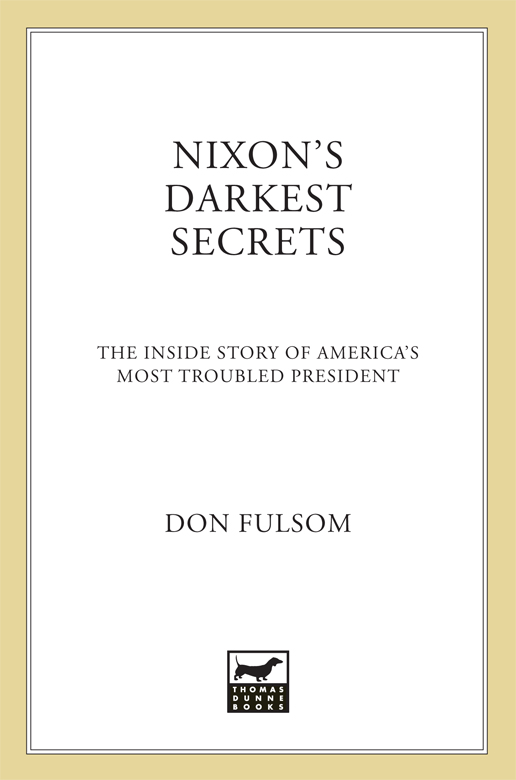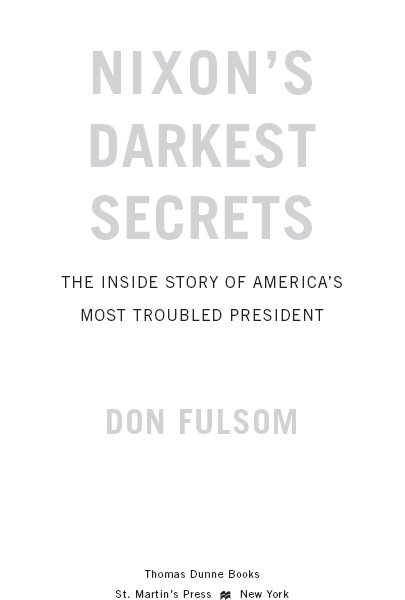
TO MY FAMILY, FRIENDS AND STUDENTS
Acknowledgments
This book was a long time in the making, and therefore I have many people to thank who have encouraged me in the varying stages that led up to publication.
I first want to thank my agent, Jane Dystel, who took my project on so enthusiastically, and Thomas Dunne of Thomas Dunne Books, who considered the book worthy of his imprint. My editor at Thomas Dunne, Rob Kirkpatrick, offered extremely helpful suggestions and encouragement as we went along, as did Robs talented assistant, Nicole Sohl.
I also want to thank those who have helped me think through the manuscript and mold it over the years. I am grateful to Linda Cashdan and her savvy book doctoring skills; Pat OConnor, Editor of CrimeMagazine.com; and several of my former students at American UniversityMadeline Cohen, Austin Trantham, Mary Jane Egan, and Tara Fircak.
I have spent a lot of time at the National Archives gathering the latest data, and archivists at the Nixon Project at the National Archives at College Park, Maryland, were very helpful, especially Steve Greene, Dick ONeill, and Allen Rice.
I want to thank my family members who offered continuous support and encouragement, led by my daughter, Beth Willett, and my sister, Deanna Nowicki, and their spousesmy son-in-law, James Willett, and brother-in-law, Frank Nowicki.
And then there were many others who made suggestions, helped with the subject matter, looked over chapters, and added their knowledge. These include: Jay Bell; Tom Foty, Tom DeLach, and Rob Thaler; Roger Gittines and Jane Berger; Bob Frishman and Jeanne Schinto; Mike Magor and Katherine Lenard; Keith Koffler; Greg Clugston; Tina Rafalovich; Larry Webb; Neal Augenstein; Jimmy Minichello; Craig Smith; Warren Corbett; Kenneth Williams; Joe Gomez; Jonnie and Jerry Mitchell; Penny Pagano; Mitch Kominsky; Patti and David Victorson; Pat Sloyan; Dan Moldea; Stanley Kutler; Rick Boardman; Robert Enelow; Devra Marcus; Glenn Fuchs; Frank Sciortino; William Klein; Bob and Nancy Sloan; Sid Davis; Muriel Dobbin; Jim McManus; Luke Nichter; Michael Hussey; Maya OConnor and Joel Tomlinson; Marc Borbely; Lee Edel; Bill McCloskey; Janette Alsford; Nicole Hollander; Dusty Rhodes; Steve and Dave Toth; Denise Gamino; Roxi Slemp; Mary Belcher; Dan and Elaine Mackolin; Candice Nelson; Bonnie Angelo; Bob Moore; Bill Scott; Dave Rosso; Charlotte Astor; Elias Demetracopoulos; Pye Chamberlayne, Maureen Kelly, and Marilyn Z. Tomlins; Ted and Cornelia McDonald; Carol Camelio; Gordon MacDougall and Linda Geurkink; Kelly Lux, Tom Gauger, Howard Dicus, and Philomena Jurey.
Contents
One |
Two |
Three |
Four |
Five |
Six |
Seven |
Eight |
Nine |
Ten |
Eleven |
Twelve |
Thirteen |
Fourteen |
Fifteen |
Sixteen |
Seventeen |
Eighteen |
Nineteen |
Twenty |
Introduction
At 8 A.M. on June 18, 1972, I was at the Key Biscayne Hotel, covering President Nixon on one of his frequent weekends in the Florida and Bahamas sunshine with Charles Bebe Rebozo, when I got a call from Washington. The caller was Tom Girard, a close buddy and former radio reporter who had gone on to become the deputy press secretary for CREEP (the Committee to Re-elect the President).
Tom was every inch a Nixon man, but he was also a straight shooter with a solid grounding in the difference between what is ethically and legally right and wrong. Tom had just read the early edition of The Washington Post in which there had been a photo of the five Watergate burglars, along with their names.
The guy theyre identifying as Edward Martin is not Edward Martin, Tom told me. Thats James McCord! Normally laid back, Tom was really riled up. McCord is the top security man for CREEP and he is a former CIA agent who was in charge of security for the CIA. McCord was always a nut about security at CREEP headquartersinstructing staffers how to thwart possible spies and such.
Tom, who had totally soured on Nixons campaign tactics, wanted to get out the news about Edward Martins true identify and its significance as soon as possiblewithout, of course, in any way implicating himself.
My story linking CREEP to the Watergate burglary was broadcast to UPI Audios 1,200 radio clients at 10:10 A.M. It was one of those reliable source stories that would be very hard to trace. Since most people in the White House press operation knew Tom and I were good friends and might have put two and two together, rather than use my own voice and a Key Biscayne dateline on the forty-five-second spot, I dictated my piece to our weekend reporter in Washington, Charles Van Dyke, who then voiced my words and signed off with his own name. And with that, I became the first reporter to link the Watergate burglary to Nixons re-election committee.
I covered the White House during the Johnson and Nixon presidencies, and although I went on to continue covering the White House during the Ford, Reagan and Clinton administrations, I never quite got over Richard Nixon. I was one of the few White House reporters who took a highly skeptical view of Nixons Watergate denials from the very beginning, grilling Nixons eventually discredited spokesman, Ron Ziegler, as hard as I could. My outrage at the dishonesty being fed to the press fueled me to score a number of significant scoops during the Nixon presidency.
I have now spent more than three decades pursuing the shadowy details of Richard Nixons deeds, and the links to illicit activities keep coming, thanks to the extensive research Ive done and the staggered release of Nixons White House tapes and documents. The new revelations give us both insight into the character of the thirty-seventh President of the United States, and an understanding of why Nixon spent an estimated $20 million in legal fees to try to keep the incriminating information private.
Nixons Darkest Secrets is about the portrait that is emerging. It is about Nixon the trickster, who burglarized the campaign office of his competitor in his first political campaign, and hired people posing as communists to hand out the opponents political literature, who secretly ordered aides to supply reporters with false information that the man who shot and crippled Alabama governor George Wallace was a left winger, and that the 1972 Democratic vice presidential candidate, Sargent Shriver, had slave-holding ancestors.
It is a book about Nixon the assassination planner. As vice president, he headed supersecret CIA/Mafia efforts to kill Cuban leader Fidel Castro, and he approved a plan to assassinate Greek shipping tycoon Aristotle Onassis (If it turns out we have to kill the bastard, he admonished an aide, just dont do it on American soil.). As president he authorized the assassination of Chilean president Salvador Allende, and made it clear to Vietnamese president Nguyen Van Thieu, in 1972, that if he kept resisting a political settlement of the Vietnam War, he might not be around long. He concocted a plan to assassinate Panamanian strongman Omar Torrijos, and only at the last moment reportedly canceled a plan to kill columnist Jack Anderson, his nemesis in the press.


